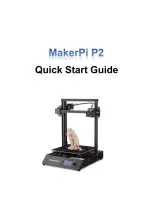
Operating Principles
The CR motor is equipped with an encoder unit which generates pulses. The
encoder belt has equally pitched slits and is mounted under the timing belt. A
photo interrupter (encoder) surrounds the encoder belt and converts the carriage
movement into a pulse train.
Left Head Damper
Holder
Paper Width Sensor
Rear CR Guide Shaft
Front CR Guide Shaft
Carriage
CR Timing Belt
Figure 2-5. Carriage Mechanism
Platen Gap Adjustment Mechanism
Figure 2-6 shows the platen gap adjustment mechanism. The front and rear
carriage guide shafts supporting the carriage have a vertical section. The rotation
PG motor is transmitted to the rear carriage guide shaft through the gears.
Counterclockwise rotation
motor expands the platen gap and clockwise
rotation reduces it.
The encoder plate with equally pitched slits is attached coaxially to the motor
axis. When the motor rotates, the PG sensor detects it and outputs the pulses.
Each pulse corresponds to detection of a 0.015 mm resolution (horizontal
distance). The system range is 0 to 0.7 mm.
EPSON
Service Manual
2-5
Summary of Contents for DFX-5000+
Page 1: ...EPSON Service Manual Epson America Inc TM DFX5K ...
Page 154: ......
Page 212: ...Appendix Table A S CN7 C117 MAIN Board Assembly A 8 EPSON DFX 5000 Service Manual ...
Page 218: ......
Page 219: ...Appendix DFX 5000 Exploded Diagram 1 EPSON DFX 5000 Service Manual A 15 ...
Page 220: ...Appendix Figure A 5 Exploded Diagram 2 A 16 EPSON DFX 5000 Service Manual ...
Page 221: ...597 J86 ...
Page 222: ...Appendix A 18 EPSON DFX 5000 Service Manual ...
Page 223: ...Appendix Figure A 7 C117 MAIN Board Circuit Diagram EPSON DFX 5000 Service Manual A 19 ...
















































